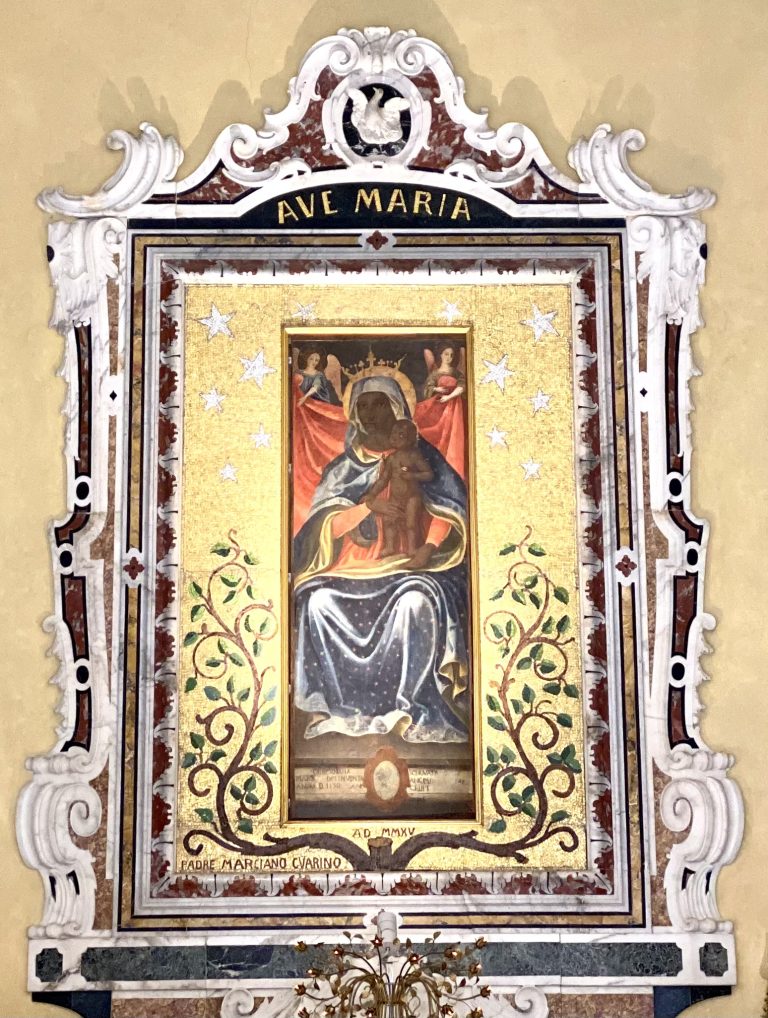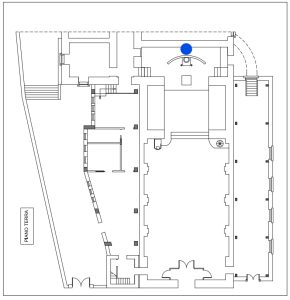Tavola Madonna con Bambino



Parrocchia Santuario Maria SS. di Carpignano
Dipinto
Madonna con BambinoAutore ignoto
Sec. XII (rimaneggiato XVII e XX sec.)Olio su tavola

Parish Sanctuary Maria SS. di Carpignano
Painting
Madonna with Child
Unknown author
XII century (remodeled in XVII and XX centuries)
Oil on table
L’opera, un dipinto ad olio su tavola di tipo bizantino, della misura di cm. 205×75, raffigura la Madonna in trono con il Bambino.
La scena rappresentata nel dipinto che si va a descrivere è molto naturale.
La Vergine, incoronata, è rappresentata seduta, con un ampio mantello blu decorato a stelle ed una tunica rossa drappeggiante. Alle sue spalle due angeli che guardano lo spettatore, sorreggono un drappo rosso che dà all’insieme il tono solenne di una Maestà. La Madonna tiene ritto, dalla parte del cuore, il Bambino Gesù, nudo, che poggia i piedi sul ginocchio sinistro materno ed ha nella mano sinistra un piccolo pavone simbolo di resurrezione e rinascita, nello stesso tempo poggia la mano destra sulla mano destra della madre. Lo sguardo della Vergine è rivolto ai fedeli, quello del Bambino rivolto alla madre, entrambi i personaggi sono rappresentati con carnagione scura.
Secondo la tradizione, che segue un topos agiografico consueto, la tavola sarebbe stata ritrovata nell’anno 1150 da alcuni pastori nel cavo di una pianta di carpine e che dopo aver tentato di portare altrove il quadro, la Madonna con segni prodigiosi, abbia voluto far capire a quei pastori che essa voleva essere venerata in questo luogo. Come a proteggere con il suo sguardo materno, dalla sommità di questa collina i tantissimi paesi irpini che si possono scorgere.
L’ultimo restauro ha dimostrato che il supporto ligneo ha un’origine orientale e che può essere datato nel XII secolo.
La tavola, con buona probabilità, è una delle tante opere d’arte trasportate dall’Oriente in occasione delle varie Crociate che, nel nostro caso, è la seconda svoltasi tra il 1145 ed il 1149.
L’opera è stata rimaneggiata più volte nel corso dei secoli tanto che non si conosce l’aspetto originale della Madonna in quanto, nel 1639, l’immagine mariana venne totalmente ridipinta nelle forme che vediamo oggi, come attestava un’iscrizione alla base dell’immagine (CRYSPIGNANA MAT [er]/ DEI INVENTA/ ANNO D(omini) 1150/ [sul lato destro] RENOVATA E[x] VOTO/ ANGEL [o/a]…A .. NO/ GRUPT[a A(nno) D(omini) 16]39, ovvero «La Madre di Dio di Carpignano rinvenuta nell’anno del Signore 1150, (fu) restaurata per voto di Angelo (o Angela) .. a .. no di Grotta nell’anno del Signore 1639), oggi parzialmente rimaneggiata.
Successivamente la tavola è stata restaurata nel 1801, nel 1871, nel 1909, nel 1950, nel 1981 e infine, nel 2004.
In particolare, va ricordato che il restauro realizzato nel 1909 fu effettuato dal pittore Vincenzo Volpe, quello del 1981 dall’artista francescano Padre Andrea Martini che, per i gravi danni causati dal terremoto del 1980, ne ha modificato notevolmente l’immagine seicentesca; il restauro effettuato nel 2004 ad opera del maestro Umberto Piezzo di Napoli il quale ha cercato di recuperare i frammenti originali dell’opera e ricostruire, nel limite del possibile, l’immagine originale seicentesca.
Il supporto dell’opera, composta da una sola asse di legno a sviluppo verticale e proveniente da un albero di noce del diametro di almeno un metro, può essere datato in base alla tecnica costruttiva con la quale è stato realizzato nel XII secolo; di contro, l’immagine, in base alla tecnica pittorica e alla tipologia mariana, tralasciando le ridipinture dei secoli successivi, può essere datata nel XVII secolo.
R. M.
The work, an oil painting on wood, measuring 205X75 cm, depicts an enthroned Madonna with the Child.
The scene represented in the painting that is going to be described is very natural.
The crowned Virgin is shown seated, with a large star-decorated blue cloak and a red draping tunic. Behind her two angels who look at the viewer hold up a red cloth that gives the whole the solemn tone of a Majesty. She has her naked son in her hands, the right hand is placed at the height of the Child’s groin while the left is placed under the left foot of the Child who, on the right side of the table, appears erect on the left knee of the mother and holds, in his left hand, a small peacock symbol of resurrection and rebirth; at the same time, he rests his right hand on his mother’s right hand. The Virgin’s gaze is turned to the faithful, that of the Child turned to the mother, both characters are represented with dark complexion.
According to the legend, which follows a usual hagiographic topos, the table was found in the year 1150 by some shepherds in the hollow of a hornbeam plant and that after trying to bring
elsewhere the picture, the Madonna with prodigious signs, wanted to make those shepherds understand that she wanted to be venerated in this place. As to protect with her maternal gaze from
top of this hill the many Irpinia villages that can be seen.
The latest restoration has shown that the wooden support has an oriental origin and that it can be dated to the 12th century.
In all probability the table is one of the many works of art transported from the East on the occasion of the various Crusades which, in our case, is the second one held between 1145 and 1149.
The work has been remodeled several times over the centuries, so much so that the original appearance of the Madonna is not known as, in 1639, the Marian image was totally repainted in the forms we see today, as attested by an inscription at the base of the image (CRYSPIGNANA MAT [er] / DEI INVENTA / ANNO D (omini) 1150 / [on the right side] RENOVATA E [x] VOTE / ANGEL [o / a] .. A .. NO / GRUPT [a A (nno ) D (omini) 16] 39, that is « The Mother of God of Carpignano found in the year of the Lord 1150, (was) restored by vote of Angelo (or Angela) .. a .. no of Grotta in the year of the Lord 1639), now partially remodeled.
Subsequently the table was restored in 1801, 1871, 1909, 1950, 1981 and, finally, in 2004.
In particular, it should be remembered that the restoration made in 1909 was carried out by the painter Vincenzo Volpe, that in 1981 by the Franciscan Father artist Andrea Martini who, due to the serious damage caused by the 1980 earthquake, has considerably modified the seventeenth-century image; the restoration carried out in 2004 by the master Umberto Piezzo from Naples who tried to recover the original fragments of the work and reconstruct, as far as possible, the original seventeenth-century image.
The support of the work, composed of a single plank of wood with vertical development and coming from a walnut tree with a diameter of at least one meter, can be dated – based on the construction technique with which it was built – to the 12th century; on the other hand, the image, based on the painting technique and the Marian typology, leaving out the repainting of the following centuries, can be dated to the 17th century.
R. M.
